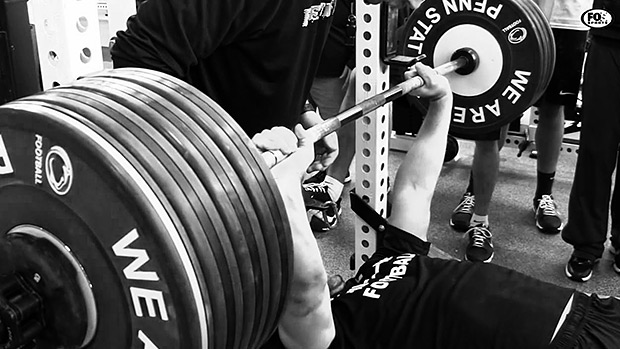You can't, or rather, you shouldn't, force feed movements. Everyone isn't built the same way. In the case of the bench press, there are a couple of things that can influence the way we approach the lift:
It'll drastically change the point of contact that the bar makes on the torso at the bottom of the bench press pattern. On top of this, it can influence just how narrow or wide the lifter places his hands in order to be in proper line with physics for an efficient press.
If you're a lifter with longer arms, it doesn't always mean a wider grip should be your bread and butter. It may mean using a grip that's a touch narrower to protect the shoulder joint, while using a lower point of contact on the torso.
The shoulder girdle – made up of the scapula, humerus, and collarbone – must allow full range of motion at the upper arm. That's why you have to improvise with movement patterns to find out what fits your skeleton best and causes you the least discomfort or pain. In severe cases, even movements like the bench press can be taxing on the shoulder joint, and it can make programming it a bit of a hassle.
Luckily, I devised some solutions to tailor the bench to your frame, regardless of arm length and shoulder construction.
There's a chance the range of motion you're using is just plain too ambitious for your injury situation or your skeletal build. But that doesn't mean you have to take horizontal pressing off the table.
Simply set yourself up in a squat cage for some pin presses, or on the floor for some floor presses. In both cases, you take advantage of something getting in the way of the bar touching the torso.
For pin presses, the pins can be set 4-6 inches off the chest.
For floor presses, your elbows will meet the ground before the bar meets the torso.
On your heavy days, stick to heavy pin press sets of 3-5 reps. They'll help charge up your nervous system and expose you to very heavy loads with two distinct advantages. First, you don't have to go as deep. Second, you can take advantage of not having to be as mindful of the eccentric/negative portion of the lift – you can bring the bar down fast because the pins will keep it from crushing your chest.
Being able to forego the eccentric and only focus on the concentric/lifting portion creates its own benefits, when applied correctly. In this case, it can allow for a greater work capacity in the given lift since you'll be fresher and less fatigued.
On lighter days, do a barbell or dumbbell floor press (I prefer dumbbell). Chase reps with this movement (10 to 15), and play around with the hand and elbow position to find one that suits your comfort and body type.
Most people rely on fat grips for improving their grip strength. They're typically intended for use with pulling exercises like rows, deadlifts, or loaded carries like farmer's walks. Using them for conventional press patterns, however, can serve a little-known purpose.
By increasing the amount of surface area in your hands, the fat grips will disperse the amount of focused load in your palm and in the corresponding joints (wrist, elbow, and shoulder). Because of the more even weight distribution, they'll make for a press that involves much less pressure on the joints. Thank me later.
In an ideal world, the humeral head should be rolled behind the collarbone during bench pressing instead of sliding forward and encouraging shoulder impingement. Poor skeletal anatomy or missed technique can cause that humeral head to come out of its lair, though.
The fix would be to change the grip of the hands so that the arms aren't forced into internal rotation from the start. A football bar may be tough to come by, but belonging to a gym that features one is probably worth the price of a membership alone.

Pressing with a neutral grip will be an initial test for the stability of the wrists, but the learning curve will be fast, and the lift itself will feel better on the shoulders, guaranteed.
When holding a barbell, it's often recommended that a bench-presser squeeze outward on the bar to engage and maintain upper back involvement.
But if you've got a good overall setup and technique, you're not going to have glaring issues keeping your back tight during your rep; you've either got a strong stable upper back or you have work to do.
But once you've set yourself up properly, you shouldn't be preoccupied with squeezing outward on the bar. It's a cue that can confuse many non-powerlifters who use the bench press as nothing more than a general chest developer and strength movement.
For that crowd, it's a smarter idea to think about squeezing IN while pressing.
There are a few reasons why I like to coach this:
- The chest fibers run horizontally and they adduct the upper arm. For more chest involvement and stimulation, pressing inward makes perfect sense. It's the reason the chest flye works so well, and the reason the squeeze press works so well.
- It's about joint centration. The amount of tension you can create pressing inward can definitely help the shoulder joint undergo distraction and help centralize the ball in the socket while bearing load.
- It's just less confusing. Especially for non-advanced lifters who aren't using a wide grip when they press. Try it and you'll see what I mean.
A healthy shoulder is still contingent on a healthy back. All four rotator cuff muscles originate on the scapulae, so starting a workout (or progressing a workout) using exercises like rows, reverse flyes, band pull-aparts, and pulldowns can only help your cause.
Adding mobility drills for the shoulder like dislocates (see video) and weighted circles would also be a smart protocol to use.
Do 3 back exercises before your workout to get the shoulder blades pulled tight and primed to support load, and then choose a movement like dislocates or weighted circles to do between each of your sets for refreshers.





